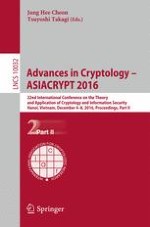2016 | OriginalPaper | Buchkapitel
How to Generate and Use Universal Samplers
verfasst von : Dennis Hofheinz, Tibor Jager, Dakshita Khurana, Amit Sahai, Brent Waters, Mark Zhandry
Erschienen in: Advances in Cryptology – ASIACRYPT 2016
Verlag: Springer Berlin Heidelberg
Aktivieren Sie unsere intelligente Suche, um passende Fachinhalte oder Patente zu finden.
Wählen Sie Textabschnitte aus um mit Künstlicher Intelligenz passenden Patente zu finden. powered by
Markieren Sie Textabschnitte, um KI-gestützt weitere passende Inhalte zu finden. powered by
